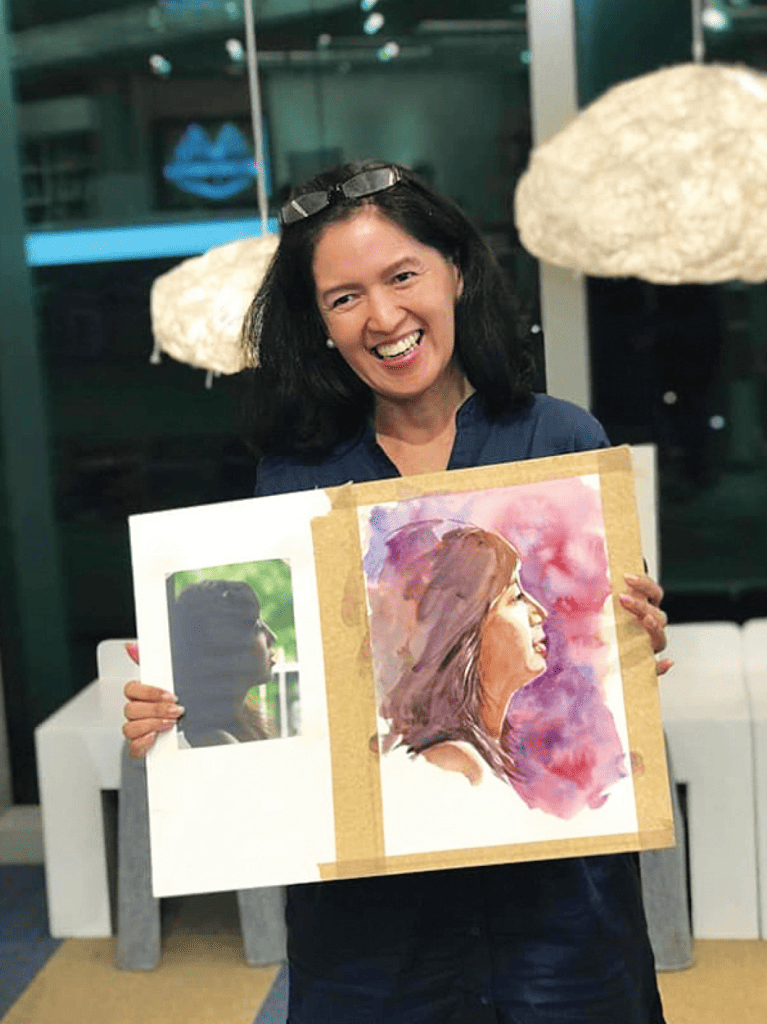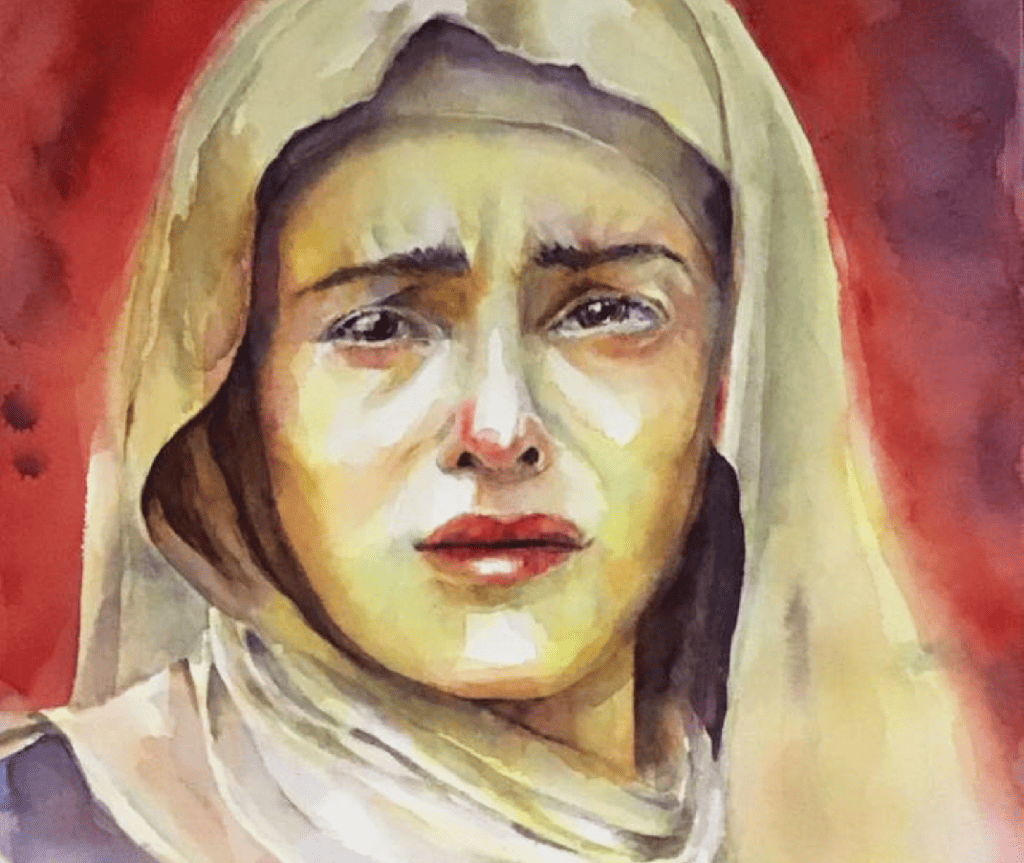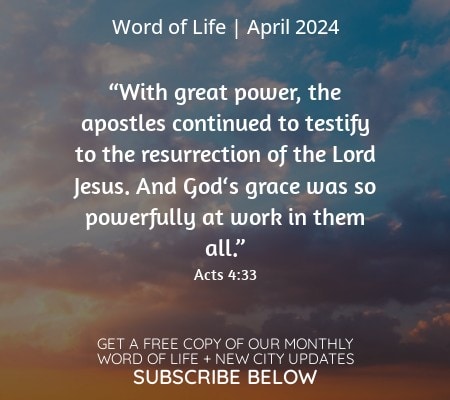Can you share something about yourself and your passion for the arts?

I must have been born holding a pencil and paper… I was raised amidst the scenic seas and hills of San Fernando City in the province of La Union. My parents were very supportive of the artistic interests of my siblings and me. Being the youngest with three older brothers, I looked up to them and was always in awe of their drawings. Being quite competitive, I would spend more hours drawing after school.
In Grade 1, I found interest in dressmaking for my Barbie dolls. So my mom bought a sack of “retaso” (scraps of clothe) from a seamstress friend, and I learned how to use my grandmother’s manual sewing machine. I then thought of becoming a fashion designer. In those early years, more interests opened doors for me. However, arts continued to be a huge part of my formative years.
Immediately after college, I pursued a demanding career in Public Relations, Advertising, Visual Merchandising and Events, which consequently set my paint brushes aside for 25 years.
Leading a demanding events company can be very stressful. Many times, I would come home and find the kids painting, and they would invite me to paint with them. Each time, I would decline because I had deadlines to beat. One day in 2019, I remember coming home tired and frustrated, but when the kids invited me again to paint with them, this time, I agreed because I missed being with them. I saw this as a chance for us to bond. I thoroughly enjoyed this time with my children, and it was a rediscovery of my love for painting. I always loved painting with oils and pastels, but on that occasion, there was a complete paradigm shift in working with watercolor.
You are part of a group of aquarellists or watercolor painters in the Philippines. Can you tell us briefly about this group?
Since I went back to painting in 2019, I had joined several art groups. I am an active member of the Artists Guild of La Union (AGLAUN), the art group in my hometown that I support. Currently, I am also the incumbent President of the Philippine Guild of Watercolorists (PGW), the largest SEC-registered watercolor organization in the Philippines that covers Luzon, Visayas, Mindanao, and even outside the country.
The group uses free resources such as social media, with its potential to reach a wider audience and inspire volunteer work to promote and teach new developments and practices in aquarelle to elevate the level of watercolor art. Being part of the international art community, we enable Filipino watercolor artists to not only promote Filipino art, but also to develop good diplomatic relations with world art communities.
Our community is committed to promoting watercolor art as a respected medium in the Philippines, so that it gains popularity and recognition, locally and internationally. The group is committed to building awareness, interest, and appreciation for watercolor and discovering, honing, and supporting local talent through its 4Es: Education, Events, Exposure and Experiences.
A very famous quote by Vincent van Gogh says, “I dream of painting and then I paint my dream.” How does this resonate with you?
Van Gogh refers to his dreams, ambitions and aspirations which he tried to bring to life through his works. In doing so, he proved to himself that he can realize them.
Perhaps, more than painting my aspirations, I am drawn more to “painting emotions” and what connects me to a subject. Either I search for a theme, or something presents itself to me that connects me to an object, a place, or an emotion felt in a situation or a memory. It’s like pausing a scene and zooming into something or someone, and hoping to capture the feeling — be it nostalgia, joy, suffering, love, humor, or hope. Human emotion is such a powerful and universal connection, and to have paintings that speak of life and give meaning to the viewer, that give him or her reasons to reflect, hope or be consoled, is for me the confirmation that I was meant to do this.
Watercolor is my preferred medium because it is very sensitive to my present state. Loose watercolor painting, which is about capturing an impression or essence of a scene, rather than painting a photographic representation, is the method I mostly practice, for it evidently shows an artist’s emotions in his or her strokes. The fluid temperament captures one’s patience or impatience at the moment, and once executed, it can no longer be taken back. It’s a perfect reminder that we only have the present moment to live well.
Can you explain what is aquarelle art? What makes it unique among painting techniques?
Aquarelle is one of the oldest and most versatile media available to everyone, so it is a preferred art method for teaching kids.
However, to professional artists, it is the most unforgiving of all media because of its unique transparent qualities that can’t be duplicated in any other medium. In saying so, you can’t also cover up mistakes. Timing, humidity, the unpredictable behavior of aquarelle, and many other factors should be considered to achieve the luminosity that watercolor is loved for. Also, aquarelle is the only medium that changes even after we’ve put down our brushes. As it dries, it continues to move, and once dry, pigments become lighter. For me, discovering the “happy accidents” is the most exciting part. Here, the artist and the medium create the painting together… and the outcome is mostly better than what you expected it to be.
In spite of this, up to recent years, aquarelle was commonly considered to be just for studies and is secondary to oils and acrylics by galleries and collectors due to the question of its longevity. Fortunately, aquarelle pigments and archival watercolor paper are now developed to withstand time and are readily available to all. Galleries and collectors are now more open to giving watercolor paintings the prestige it deserves.
What is your most loved artwork? Can you say something about it and the reason why it stands out among your aquarelle works?

I am attached to all my works, so I love them all, I guess… and it’s always hard to let go when they’re bought. However, the most meaningful to me is my “La Desolata.” It was one of my earliest portrait paintings I painted during the first months of the pandemic. For some reason, I woke up one morning with a huge desire to paint Mary as the “Desolate Mother.” As it is with all my paintings, it took me a while before I got started. But I remember crying while painting it… and I don’t know why.
After I shared it online, I received the most messages on a painting to date. Most shared their being moved by it. One said, “Ramdam ko ang kirot” (I feel the pain) … It’s very meaningful because the message reached and touched many souls.
Lately, I’ve come across articles on Mary’s miracles in Fatima (Portugal) and Akita (Japan), and their messages calling for repentance. More than before, this painting’s message seems to resonate even more.
Then, I remember Pope Francis said: “The role of art is to put a thorn in the heart, which moves us to contemplation, and contemplation puts us on a path.”
This piece, I feel, took on the Pope’s challenge. And with it, confirmed in me my purpose — why I’ve been given this gift, why I went through so many difficulties in life, why I am called to a life of unity, and why I am now where I am in this vast world of the arts.
If you were to paint an aquarelle artwork in the context of the current situation of the world, what would it be like, and why?
That’s tough. If we look around us, each one of us can easily be overwhelmed by the sufferings, injustice, calamities, destruction, and more negativity… But I would like to highlight more the positive than the negative. I’d love to paint subjects on unconditional love like that of a mother — things that would remind someone of beautiful memories, places where the viewer remembers special moments with people they love, or flowers that speak of the beauty of nature.
As artists, we may not be able to change the world abruptly. But through works of art, we can connect to the human heart… and we have an important role to lead those connections to positivity.
Pope Francis challenged artists to be “preachers of beauty” and “agents of healing.” He prayed “that artists of our time, through their creativity, may help us discover the beauty of creation.”
I take it one piece at a time, and I hope to use my talent, together with many others, to bring back beauty to the world, for truly “beauty connects us to God.”
Great artists have left their mark on human history. What would you like to be remembered for as an artist?
In the Artists’ Congress I attended in Rome in 1999, I vividly remember Chiara Lubich, the foundress of the Focolare Movement, who addressed all visual and performing artists in this event, saying: “If one day, people will refuse to listen or speak of God, God will continue to speak to men through the arts.” From then on, I wanted to adhere to those words — which manifested in my stint in advertising, visual merchandising, the events industry, and so much more now in the visual arts.
I strongly believe that paintings are there not merely to have something beautiful to hang on the wall. They are made to speak to the “beholder,” someone who sees or experiences things, becoming aware of them. If my painting can resonate with someone, only then will my painting find its value.
And if my painting continues to tug at someone’s heart long after I’m gone, then the legacy of what I believe and live for will live on, that is — in each of our stories, there is beauty. And in beauty, there is God… Then, maybe, through this, I will truly honor God by using and growing the gifts He has given me to fulfill His design for humanity.
Interview by Romeo Pelayo Vital





Thanks for sharing your art. And the heart behind it. I hope one day I’ll find the spirit to pick up a brush. When I was in Melbourne, I brought a canvas to Fossil Bay. Knowing that I could not take the shells and stones home with me, along with trash. So I just took their imprints using mud. I’d like to finish the work one day by incorporating elements from different indigenous and religious art that I’ve encountered in my travels: mandala, rangoli, Islamic, Pacific tapas, Australian aboriginal… Hoping one day it could be a series of retracing these imprints left by both nature and humanity…